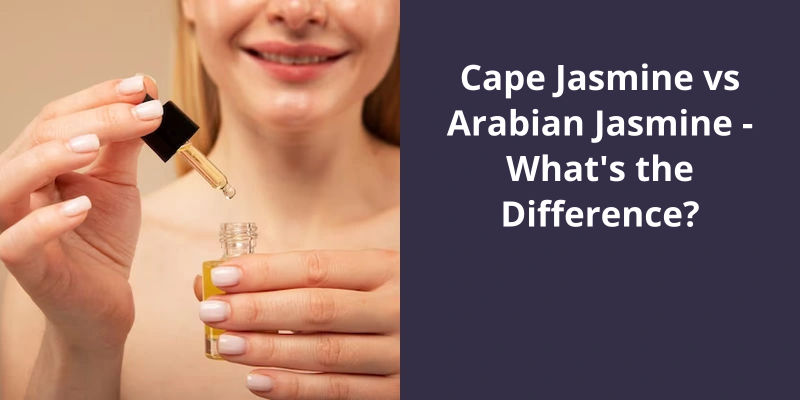Cape Jasmine and Arabian Jasmine are two distinct types of jasmine plants popular for their fragrant flowers. The main difference between the two is their origin and visual appearance. Cape Jasmine, also known as Gardenia jasminoides, originates from Asia and has large white, rose-like flowers that are very fragrant. On the other hand, Arabian Jasmine, known as Jasminum sambac, is native to a small region in the eastern Himalayas and has smaller, less complex flowers but with an equally intoxicating scent. Both types are often used in perfumes but they thrive in different environments, with Cape Jasmine preferring cooler climates and Arabian Jasmine doing well in more tropical conditions.

What Are the Characteristics of Arabian Jasmine Leaf?
The leaves of Arabian jasmine are oval to lance-shaped, glossy, and dark green in color. They’re arranged alternately on the stem. The leaves are evergreen, meaning they stay on the plant throughout the year, providing year-round interest to the garden. The leaves have a smooth texture and feel waxy to the touch. They’re about 2-4 inches long and 1-2 inches wide.
The leaves of Arabian jasmine are an important component of traditional medicine in many cultures. They contain essential oils that have antiseptic, pain relieving, and anti-inflammatory properties. The oil extracted from the leaves is used to treat skin diseases, headaches, migraines, and fever. It’s also used as a perfume and in aromatherapy.
They’re used to flavor tea, rice dishes, desserts, and curries. In Indian cuisine, the leaves are used to flavor biryanis, pulaos, and meat dishes. In the Middle East, the leaves are used to flavor meat dishes and pastries. In Indonesia and Malaysia, the leaves are used to flavor rice, soups, and stews.
They’re used to make face masks and hair treatments that nourish and moisturize the skin and hair. The essential oil extracted from the leaves is used in perfumes, soaps, and lotions.
They’re used in religious ceremonies and rituals in many cultures. In Hinduism, the leaves are used to worship the goddess Lakshmi, who represents wealth and prosperity. In Islam, the leaves are used to make garlands and decorations for festivals and weddings. In Chinese culture, jasmine tea is a symbol of friendship and hospitality.
They’ve medicinal, culinary, cosmetic, and cultural significance. They’re an essential component of traditional medicine, cuisine, and beauty products.
When it comes to fragrant flowers, jasmine is certainly one of the most popular choices. However, not all jasmines are created equal. In fact, there are several different types of jasmine, each with their own unique characteristics. One common question that arises is the difference between jasmine and Arabian jasmine. While they may sound similar, they actually have some notable distinctions.
What Is the Difference Between Jasmine and Arabian Jasmine?
Jasmine and Arabian Jasmine are two closely related species of flowering plants that are often confused for one another. They both belong to the Oleaceae family and are native to the tropical regions of Asia and Africa. While the two species share many similarities, there are some distinct differences between them that set them apart.
They prefer full sun to partial shade and well-drained soil. However, Arabian jasmine plants are generally more tolerant of dryer conditions than jasmine plants, which can be sensitive to drought.
In addition to their ornamental value, both jasmine and Arabian jasmine plants have a long history of medicinal use in traditional medicine practices.
Source: Arabian Jasmine: Bounteous Benefits Of This Fragrant Flower …
The scent of jasmine, particularly Arabian jasmine, has a unique and enticing profile that’s been used for various purposes throughout history. From it’s potential to act as an aphrodisiac to it’s use in aromatherapy, jasmine’s sweet, musky, and sultry scent has captured the attention of many. However, it’s softer, more floral and green grandiflorum counterpart is equally captivating, with it’s fresh and soothing aroma. In this article, we delve deeper into the fascinating world of jasmine and explore it’s uses and benefits.
What Is the Scent of Arabian Jasmine?
The scent of Arabian jasmine is often described as warm, luxurious, and exotic. It’s a floral scent that’s both sweet and musky, with a hint of sultriness that adds to it’s allure. The aroma of jasmine sambac, in particular, is known for it’s rich and intense fragrance that can be detected from a distance. It’s unique scent profile has made it a popular choice among perfumers and aromatherapists alike.
It’s flowers are small and delicate, and they bloom in abundance, releasing their intoxicating aroma into the air. The oil extracted from the petals of jasmine sambac is also used in aromatherapy to promote relaxation and reduce anxiety.
Jasmine grandiflorum, on the other hand, has a softer and more delicate scent profile. This type of jasmine is native to India and is known for it’s fresh and green aroma, with notes of floral sweetness. It’s commonly used in the production of high-quality perfumes and is often blended with other floral scents to create a complex and sophisticated fragrance.
In traditional Indian medicine, jasmine is believed to have aphrodisiac properties and is often used to enhance libido and sexual pleasure. In ancient Rome, jasmine was used in love spells and was considered a symbol of beauty and sensuality.
Today, jasmine remains a popular ingredient in perfumes, body lotions, and other beauty products. It’s sweet and seductive scent has a universal appeal, and it’s therapeutic properties have made it a valuable tool in aromatherapy.
Jasmine lovers always look for ways to keep their gardens adorned with it’s fragrant blooms all year round. Luckily, there are some varieties of jasmine that bloom continuously throughout the year, including the Royal Jasmine. This smaller variety of climbing jasmine is ideal for warm climates, producing sweet-smelling pure-white flowers almost all year long. Let’s delve deeper into the characteristics of the Royal Jasmine and learn how to grow it successfully.
What Kind of Jasmine Blooms All Year?
One of the most popular varieties of jasmine that blooms all year long is the Royal Jasmine (Jasminum nobile or Jasminum rex). This climbing plant is relatively smaller in stature and is typically native to warmer climates. The Royal Jasmine produces sweet-smelling pure-white flowers that are extremely fragrant and attractive. The flowers are delicate and are known to bloom nearly all year long, making it a favorite among gardeners and homeowners.
Not only does the Royal Jasmine produce beautiful, fragrant blooms, but it’s also a popular choice for hedges, walls, and trellises. The plant can grow up to six feet tall and can be pruned regularly to maintain it’s size and shape. It’s easy to grow and can thrive in full sun or partial shade, making it an ideal choice for many gardens and landscapes.
In addition to it’s aesthetic appeal, the Royal Jasmine is also known for it’s medicinal properties. The plant has been used in traditional medicines for centuries and is believed to have anti-inflammatory, anti-bacterial, and anti-viral properties. It’s also used to treat a variety of ailments, including headaches, fever, and skin irritations.
It’s year-long blooms, attractive foliage, and medicinal properties make it a popular choice for gardeners and homeowners alike.
Different Varieties of Jasmine That Bloom All Year Long
There are many different types of jasmine plants that have the ability to bloom throughout the entire year. This ensures that there will always be a fragrant and beautiful flower present, regardless of the season.
Proper pruning is an essential part of maintaining a healthy and visually appealing garden. And when it comes to pruning Cape jasmine gardenias, there are a few essential tips to keep in mind. From timing to technique, read on to learn how to prune your Cape jasmine gardenia for optimal growth and beauty.
How Do You Prune a Cape Jasmine Gardenia?
Once your Cape jasmine gardenia has bloomed in the spring, it’s time to prune it back to a manageable height. The optimal height for this shrub is around 5 feet. You can trim it down to this level to keep it in check and prevent it from growing too tall, which could cause it to become top-heavy and lose it’s attractive shape.
When pruning Cape jasmine gardenias, it’s important to keep an eye on the shape of the plant. You want it to maintain a natural, mounding habit, without any awkward branches or gaps. You can achieve this by cutting back any stems that are too long or extending too far from the base of the plant.
By doing so, youll be able to promote new growth and ensure that the plant is healthy and vigorous. Be sure to use sharp, clean shears to make precise cuts and avoid damaging the living tissue of the plant.
This will give the plant time to recover and produce new growth. When youre ready to prune again, aim to achieve a final height that suits your preferences. You can always adjust the height by cutting back the stems accordingly.
With a little bit of care and attention, you can keep your gardenia looking it’s best for many years to come. Remember to prune after flowering in the spring, remove any old or damaged stems, and maintain a mounded habit for optimal results.
Conclusion
While Cape jasmine is known for it’s glossy leaves and large, fragrant flowers, Arabian jasmine is favored for it’s delicate, white blooms with a sweet aroma. However, both plants need adequate care and attention to thrive, including proper watering, pruning, and fertilization. Ultimately, the choice between the two will depend on personal preference and the specific location and growing conditions.





